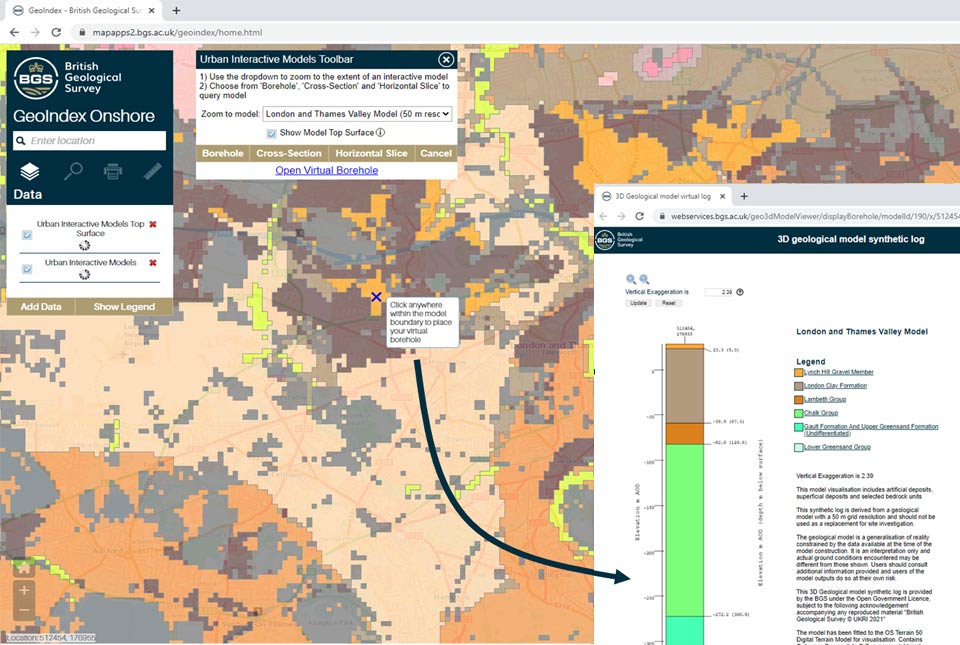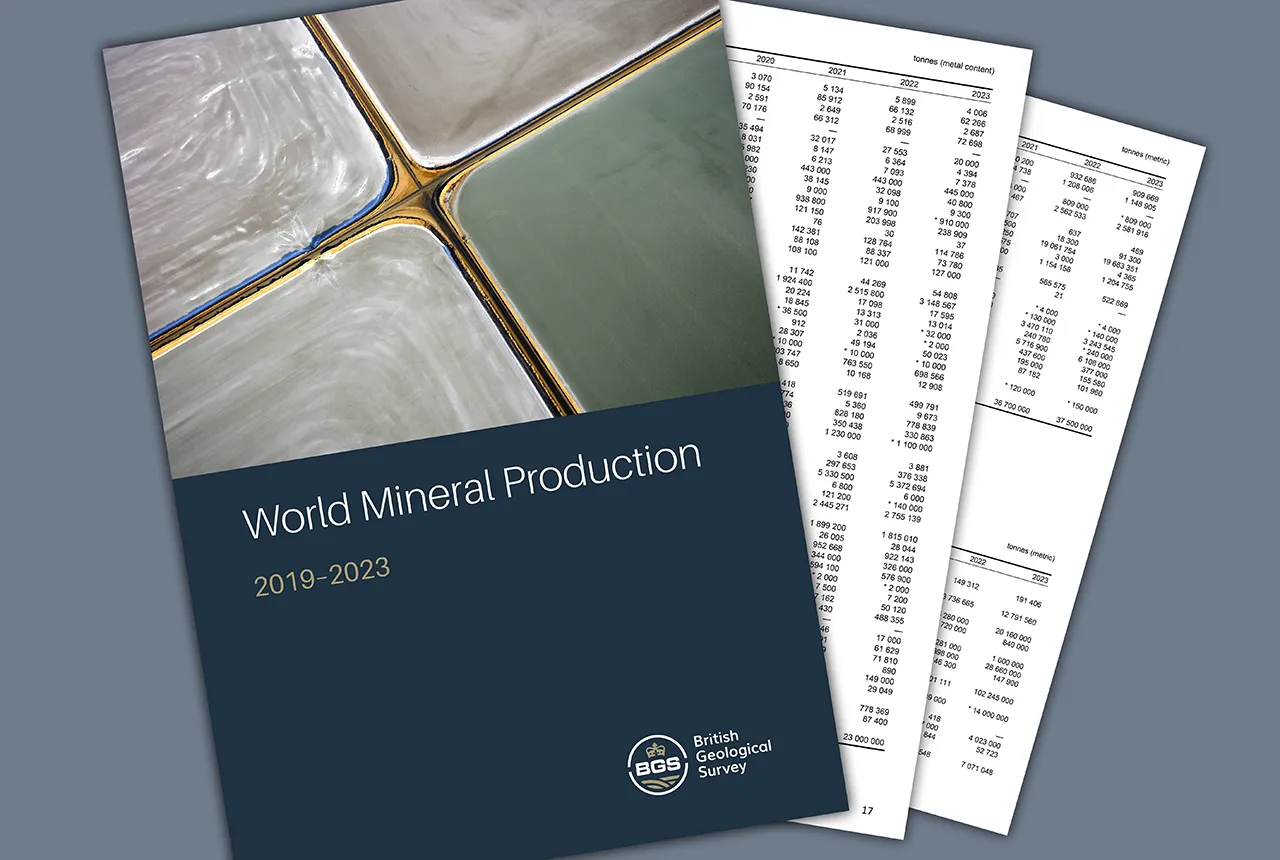New tool provides users with free access to geological models for three major UK cities
A new tool providing free user access to 3D geological models has been added to the GeoIndex.
18/11/2021 By BGS Press
A new urban interactive models tool, providing free user access to geological models for selected UK cities, has been added to BGS’s GeoIndex service.
BGS GeoIndex already provides access to a range of 2D information and data resources through an interactive map viewer, enabling users to navigate to their area of interest, view and query datasets, download reports and clip data, and make enquiries.
The new tool allows users to capture synthetic boreholes, geological cross-sections and slices through 3D models developed by BGS for London, Glasgow and Cardiff, the largest cities in England, Scotland and Wales.
A range of technical, professional and academic users, in particular consultancy for the geotechnical, construction and groundwater sectors, will benefit from the tool, which makes key urban models freely accessible for the first time.
The models provide regional geological understanding (50 m resolution) designed to help users develop conceptual ground models and plan ground investigations.
Users can query the geological model to obtain a range of visualisations of geological conditions beneath each of the cities. The views can also be downloaded as a standard format PDF.


3D urban geology on the BGS GeoIndex. BGS © UKRI.
Each of the geological models was constructed through the analysis of thousands of borehole records and integration with geological map data, informed by extensive literature review. In addition to the virtual borehole and section functions, a new slice function is being trialled for displaying geological units at specified depths.
Katie Whitbread, who leads the national geological modelling programme at the BGS, said the tool helps inform the development of conceptual ground models for construction and groundwater management, as well as supporting early-stage planning.
Urban geological models encapsulate a huge amount of geological data and knowledge to provide comprehensive 3D information on the variability of the rocks and sediments underlying our cities. Understanding this variability is critical for de-risking decision making and investment in a range of applications from construction to the management of surface and groundwater.
Conceptual ground models are a key component of early planning and desktop studies, helping to identify potential risks, develop hypotheses around ground conditions, optimise the design of targeted investigations and allow communication of the geological conditions to different stakeholders.
The urban interactive model tool adds value to the initial stages of this development process, providing accessible regional geological understanding for key UK cities, derived directly from three-dimensional geological characterisation of the upper few 100 m of the ground.
Katie Whitbread, project manager, BGS National Geological Model.
Through the tool, users can link to other BGS resources including the lexicon, model metadata reports and relevant research reports for the selected cities, and access wider 2D and 3D data services.
The underlying model data, along with a range of other BGS LithoFrame models, can be licensed through BGS Data Services, who can also arrange academic licences. BGS also provides bespoke modelling services and commissioned research for users requiring access to more detailed information. Users are encouraged to provide feedback by email to BGS Enquiries and are invited to get in touch if they are interested in being part of a user forum to help inform the design and development of new features and functions.
Whilst the tool is not intended to provide a substitute for detailed site investigations and we recognise these evaluations require additional information, the geological model provides a baseline dataset and regional context that, crucially, can inform early decision making, particularly at the desk study stage.
We are committed to working closely with potential users and stakeholders to develop the model and explore how BGS can advance its 3D geology services to help support planning and resource assessments.
Working with our stakeholders, we would like to explore future development of the tool such as increasing the coverage of UK urban areas, adding geotechnical and hydrogeological information and providing additional digital output formats so that GeoIndex continues to provide subsurface knowledge where it is needed most.
Katie Whitbread, project manager, BGS National Geological Model.
The new tool can be accessed by opening the onshore GeoIndex online and navigating to the new ‘3D models’ layer, under the data list.
Relative topics
Related news

Release of over 500 Scottish abandoned-mine plans
24/06/2025
The historical plans cover non-coal mines that were abandoned pre-1980 and are available through BGS’s plans viewer.

New collaboration aims to improve availability of real-time hazard impact data
19/06/2025
BGS has signed a memorandum of understanding with FloodTags to collaborate on the use of large language models to improve real-time monitoring of geological hazards and their impacts.

Modern pesticides found in UK rivers could pose risk to aquatic life
17/06/2025
New research shows that modern pesticides used in agriculture and veterinary medicines have been found for the first time in English rivers.

Goldilocks zones: ‘geological super regions’ set to drive annual £40 billion investment in jobs and economic growth
10/06/2025
Eight UK regions identified as ‘just right’ in terms of geological conditions to drive the country’s net zero energy ambitions.

Upgraded web portal improves access to geomagnetism data
02/06/2025
BGS’s geomagnetism portal, which holds data for over 570 observatories across the world, has received a significant update.

BGS digital geology maps: we want your feedback
29/05/2025
BGS is asking for user feedback on its digital geological map datasets to improve data content and delivery.

What is the impact of drought on temperate soils?
22/05/2025
A new BGS review pulls together key information on the impact of drought on temperate soils and the further research needed to fully understand it.

UK Minerals Yearbook 2024 released
21/05/2025
The annual publication provides essential information about the production, consumption and trade of UK minerals up to 2024.

BGS scientists join international expedition off the coast of New England
20/05/2025
Latest IODP research project investigates freshened water under the ocean floor.

New interactive map viewer reveals growing capacity and rare earth element content of UK wind farms
16/05/2025
BGS’s new tool highlights the development of wind energy installations over time, along with their magnet and rare earth content.

UKRI announce new Chair of the BGS Board
01/05/2025
Prof Paul Monks CB will step into the role later this year.

Latest mineral production statistics for 2019 to 2023 released
28/04/2025
More than 70 mineral commodities have been captured in the newly published volume of World Mineral Production.



